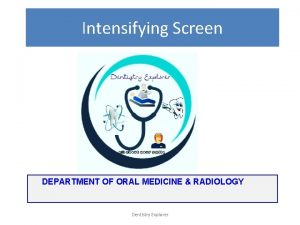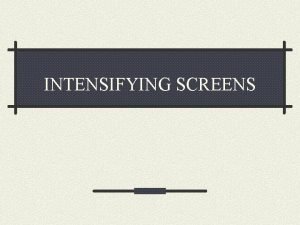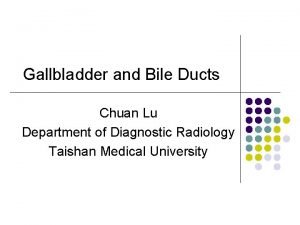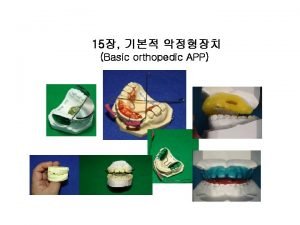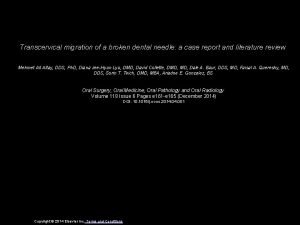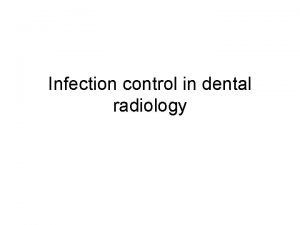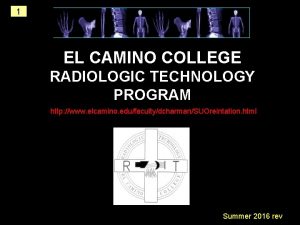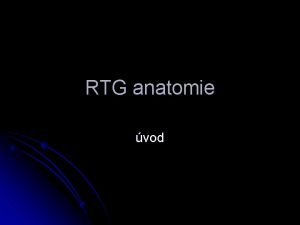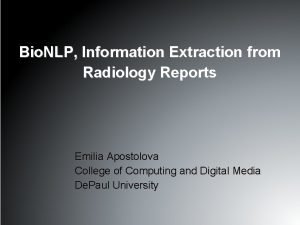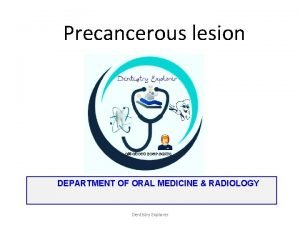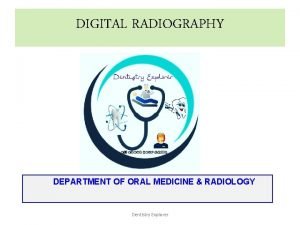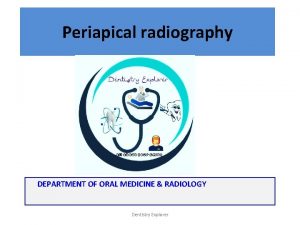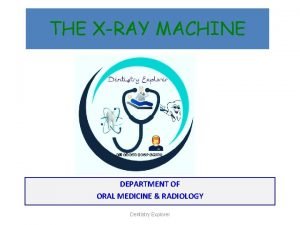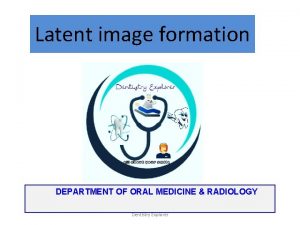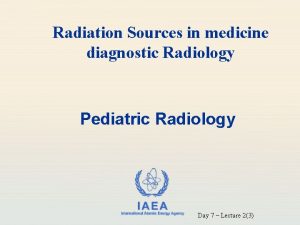Intensifying Screen DEPARTMENT OF ORAL MEDICINE RADIOLOGY Dentistry























- Slides: 23

Intensifying Screen DEPARTMENT OF ORAL MEDICINE & RADIOLOGY Dentistry Explorer

SCREEN FILM • Film emulsions are sensitive to both x-ray photons and visible light. • Film intended to be exposed by x rays is called direct exposure film. All intraoral dental film is direct exposure film. • Screen film, which is sensitive to visible light, is used with intensifying screens that emit visible light. Screen film and intensifying screens are used for extraoral projections such as panoramic and skull radiographs. Dentistry Explorer

• For extraoral radiography, screen film is used with intensifying screens to reduce patient exposure. • Screen film is designed to be sensitive to visible light because it is placed between two intensifying screens when an exposure is made. • The intensifying screens absorb x rays and emit visible light, which exposes the screen film. Dentistry Explorer

• Silver halide crystals are inherently sensitive to ultraviolet (UV) and blue light (300 to 500 nm) and thus are sensitive to screens that emit UV and blue light. • When film is used with screens that emit green light, the silver halide crystals are coated with sensitizing dyes to increase absorption. • Because the properties of intensifying screens vary, appropriate screen-film combination recommended by the screen and film manufacturer so that the emission characteristics of the screen match the absorption characteristics of the film. Dentistry Explorer

• Faster films require less radiation exposure but these provide less image detail. • Such films should be considered for panoramic radiography when fine image detail is not available because of movement of the x-ray tube head during the exposure. • Another type of film provides less contrast and a wider latitude. This type reveals a wide range of densities and is most suitable for cephalometric radiography, when both bony and soft tissue details are desired Dentistry Explorer

Intensifying Screen • Early in the history of radiography, scientists discovered that various inorganic salts or phosphors fluoresce (emit visible light) when exposed to an x-ray beam. • The intensity of this fluorescence is proportional to the x-ray energy absorbed. • These phosphors have been incorporated into intensifying screens for use with screen film. • The sum of the effects of the x rays and the visible light emitted by the screen phosphors exposes the film in an intensifying cassette. Dentistry Explorer

Function • The presence of intensifying screens creates an image receptor system that is 10 to 60 times more sensitive to x rays than the film alone. • Intensifying screens reduces dose of x radiation to which the patient is exposed. • Intensifying screens are used with films for virtually all extraoral radiography, including panoramic, cephalometric, and skull projections. • In general, the resolving power of screens is related to their speed: the slower the speed of a screen, the greater its resolving power and vice versa. • Intensifying screens are not used with periapical films because their use would reduce the resolution of the resulting image below that necessary for diagnosis of much dental disease Dentistry Explorer

COMPOSITION • Intensifying screens are made of a base supporting material, a phosphor layer, and a protective polymeric coat. • In all dental applications, intensifying screens are used in pairs, one on each side of the film, and they are positioned inside a cassette. • Cassette holds each intensifying screen in contact with the x-ray film to maximize the sharpness • of the image. • Most cassettes are rigid, but they maybe flexible. Dentistry Explorer

Cassette Dentistry Explorer

Dentistry Explorer

Base • Polyester plastic that is about 0. 25 mm thick. • Provides mechanical support for the other layers. • In some reflective; thus it reflects light emitted from the phosphor layer back toward the x-ray film, increasing the light emission of the intensifying screen but results in image "unsharpness“ due to divergence of light rays reflected. • Some fine detail intensifying screens omit the reflecting layer to improve image sharpness. • Others base is not reflective, and a separate coating of titanium dioxide is applied to the base material to serve as a reflecting layer. Dentistry Explorer

Phosphor Layer • Composed of phosphorescent crystals suspended in a polymeric binder. When the crystals absorb x-ray photons, they fluoresce • The phosphor crystals often contain rare earth elements, most commonly lanthanum and gadolinium. • Their fluorescence can be increased by the addition of small amounts of elements such as thulium, niobium, or terbium. • Some rare earth compounds are efficient phosphors. • In the energy range typically used in dental radiography, a pair of rare earth intensifying screens absorbs about 60% of the photons that reach the cassette after passing through a patient. • These phosphors are about 18% efficient in converting this x-ray energy to visible light. Dentistry Explorer

• Rare earth screens convert each absorbed x-ray photon into about 4, 000 lower-energy, visible light • (green or blue) photons then expose the film. • Different phosphors fluoresce in different portions of the spectrum. • For example, light emission from Kodak Lanex (rare earth) from 375 to 600 nm and peaks sharply at 545 nm (green). • Other intensifying screens have a major peak at 350 nm (UV) and another at 450 nm (blue). • It is important to match green-emitting screens with green-sensitive films and blue-emitting screens with blue-sensitive films. Dentistry Explorer

Dentistry Explorer

The speed and resolution of a screen depends on many factors including: • Phosphor type and phosphor conversion efficiency • Thickness of phosphor layer and coating weight (amount of phosphor/unit volume) • Presence of reflective layer • Presence of light-absorbing dye in phosphor binder or protective coating • Phosphor grain size Dentistry Explorer

• Fast screens have large phosphor crystals and efficiently • convert x-ray photons to visible light but produce images with lower resolution. • As the size of the crystals or the thickness of the screen decreases, the • speed of the screen also declines but image sharpness increases. • Fast screens also have a thicker phosphor layer and a reflective layer, but these properties also decrease sharpness. • In deciding on the combination to use, the practitioner must consider the resolution requirements of the task for which the image will be used. • Table 4 -3 shows several contemporary screens and their speed class. Most dental extraoral diagnostic tasks can be accomplished with screen-film combinations that have a speed of 400 or faster Dentistry Explorer

Protective Coat • A protective polymer coat (up to 15 micro m thick) is placed over the phosphor layer to protect the phosphor and provide a surface that can be cleaned. • The intensifying screens should be kept clean because any debris, spots, or scratches may cause light spots on the resultant radiograph Dentistry Explorer

• Compared calcium tungstate screens, rare earth screens decrease patient exposure 55% in panoramic and cephalometric radiography. • Reduction in patient exposure may be achieved with the use of T-grain film by the Eastman Kodak Company in 1983. • Film contains silver halide grains that are tabular or flat rather than pebblelike in shape Dentistry Explorer

Dentistry Explorer

• Tabular (T) grains oriented with their relatively large, flat surfaces facing the radiation source, providing a larger cross-section (target) increases their ability to gather light from intensifying screens and resulting in increased speed without loss of sharpness • T-grain film used with rare earth screens is twice as fast as calcium tungstate screen-film combinations and 11/3 times as fast as conventional rare earth screenfilm combinations with no loss in image quality. Dentistry Explorer

• Image resolution that is about half that of direct film due to crossover • loss of image sharpness and resolution resulting from light emitted by one screen passing through the film to expose the emulsion on the opposite side of the double emulsion film. • The Ultra-Vision (Du. Pont) and Ektavision (Kodak) screen film systems were designed to minimize crossover by using phosphors that emit ultraviolet light, which is less able to pass through the film base to expose the opposite emulsion. Dentistry Explorer

• Green-sensitizing dyes (benzoxazolo carbocyanine) are added to the surface of the tabular grains. • Increases light-gathering capability and reducing the crossover. • Higher resolution than corresponding rare earth screen-film systems. This allows for the use of a screen one speed class higher and a 50% reduction in patient exposure. Dentistry Explorer

• Kodak's new Ektavision system includes an absorbing dye in the emulsion to prevent crossover of light from one screen to the other emulsion. • This increases the sharpness of the image. Unlike digital intraoral imaging, there is no significant dose reduction to be gained by replacing extraoral screenfilm systems with digital imaging. Dentistry Explorer
 Oral medicine and radiology day
Oral medicine and radiology day Dentistry
Dentistry Intensifying screen layers
Intensifying screen layers American academy of oral and maxillofacial radiology
American academy of oral and maxillofacial radiology Screen small screen offscreen
Screen small screen offscreen Gallbladder length
Gallbladder length Faculty of medicine dentistry and health sciences
Faculty of medicine dentistry and health sciences Dentistry & oral sciences source
Dentistry & oral sciences source Oral screen
Oral screen Initiating experimenting intensifying integrating bonding
Initiating experimenting intensifying integrating bonding What does intensifying mean
What does intensifying mean Oral pathology
Oral pathology Department of medicine solna
Department of medicine solna Mcgill medicine supporting documents
Mcgill medicine supporting documents Infection control in dental radiology
Infection control in dental radiology El camino college radiology
El camino college radiology Anatomie l
Anatomie l Projected maxilla
Projected maxilla Veterinary radiology dallas county
Veterinary radiology dallas county Radiology terminology
Radiology terminology Osu radiology tulsa
Osu radiology tulsa Nlp radiology reports
Nlp radiology reports Enteroclysis vs barium follow-through
Enteroclysis vs barium follow-through Srtp radiology
Srtp radiology

